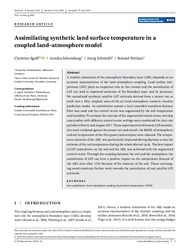Assimilating synthetic land surface temperature in a coupled land–atmosphere model
DOI: https://doi.org/10.1002/qj.3883
Persistent URL: http://resolver.sub.uni-goettingen.de/purl?gldocs-11858/9150
Persistent URL: http://resolver.sub.uni-goettingen.de/purl?gldocs-11858/9150
Sgoff, Christine; Schomburg, Annika; Schmidli, Juerg; Potthast, Roland, 2020: Assimilating synthetic land surface temperature in a coupled land–atmosphere model. In: Quarterly Journal of the Royal Meteorological Society, DOI: 10.1002/qj.3883.
 |
Dokument öffnen: |
A realistic simulation of the atmospheric boundary layer (ABL) depends on an accurate representation of the land–atmosphere coupling. Land surface temperature (LST) plays an important role in this context and the assimilation of LST can lead to improved estimates of the boundary layer and its processes. We assimilated synthetic satellite LST retrievals derived from a nature run as truth into a fully coupled, state-of-the-art land–atmosphere numeric weather prediction model. As assimilation system a local ensemble transform Kalman filter was used and the control vector was augmented by the soil temperature and humidity. To evaluate the concept of the augmented control vector, two-day case-studies with different control vector settings were conducted for clear-sky periods in March and August 2017. These experiments with hourly LST assimilation were validated against the nature run and overall, the RMSE of atmospheric and soil temperature of the first-guess (and analysis) were reduced. The temperature estimate of the ABL was particularly improved during daytime as was the estimate of the soil temperature during the whole diurnal cycle. The best impact of LST assimilation on the soil and the ABL was achieved with the augmented control vector. Through the coupling between the soil and the atmosphere, the assimilation of LST can have a positive impact on the temperature forecast of the ABL even after 15 hr because of the memory of the soil. These encouraging results motivate further work towards the assimilation of real satellite LST retrievals.
Statistik:
ZugriffsstatistikSammlung:
This is an open access article under the terms of the Creative Commons Attribution License, which permits use, distribution and reproduction in any medium, provided the original work is properly cited.

